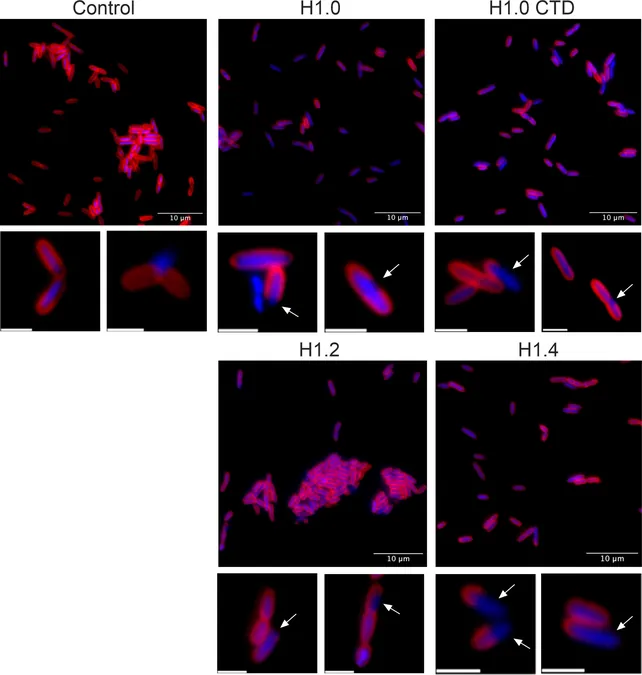
Revolutionary Discovery: Human Histones Could Be the Key to Overcoming Antibiotic Resistance!
2024-11-01
Author: Sarah
Introduction
In an era marked by the lifesaving power of antibiotics, we find ourselves at a critical crossroads. Antimicrobials, hailed as one of the most important medical breakthroughs of the 20th century, have prevented countless deaths from infectious diseases. Yet, the dramatic rise in antibiotic use—and abuse—has led to a daunting global challenge: antibiotic resistance.
This burgeoning crisis is estimated to contribute to a staggering 1.27 million deaths worldwide each year, sparking urgent calls for innovative solutions.
The Growing Crisis of Antibiotic Resistance
The scenario has become increasingly dire. Common pathogens like Escherichia coli, Staphylococcus aureus, and Pseudomonas aeruginosa have acquired resistance against multiple antimicrobial agents. This growing resistance translates to higher mortality rates, longer hospital stays, and skyrocketing healthcare costs, with projections suggesting that resistant infections could claim up to 10 million lives annually by 2050 if left unchecked.
A Promising Lead: Human Histones
However, hope appears on the horizon. A pioneering study led by Eduard Torrents from the Institute for Bioengineering of Catalonia (IBEC) offers a promising lead. The research, just published in the journal mSystems, unveils an unexpected ally in the fight against superbugs: human histones.
These crucial proteins, primarily known for their role in DNA organization within eukaryotic cells, have exhibited significant antimicrobial properties against various bacteria, including biofilms of the notoriously resistant Pseudomonas aeruginosa.
The Mechanism of Action of Histones
Histones, particularly subtype H1, have shown a remarkable ability to be released into extracellular spaces to engage harmful microorganisms directly. The study highlights that histones can latch onto bacterial membranes, inflicting considerable damage and ultimately leading to their demise.
This novel approach has revealed a reduction of up to 70% in P. aeruginosa counts after histone treatment, which is groundbreaking in the context of tackling resistant infections.
Synergistic Effects and Clinical Potential
Even more intriguing is the synergistic effect observed when combining these histones with the antibiotic ciprofloxacin. The combination showcased an enhanced antimicrobial effect over their individual uses, promising a new frontier for treatment regimens.
Additionally, the researchers successfully demonstrated a 30% reduction in bacterial mass within biofilms—the stubborn protective communities that are notoriously hard to eradicate and are responsible for many chronic infections.
Promising In Vivo Results
These findings are not merely theoretical. In vivo tests using wax worms infected with P. aeruginosa showed that those treated with histones exhibited increased survival rates, underlining their potential for clinical applications without evident toxicity.
Conclusion and Future Directions
Given the urgent need for novel antimicrobials, the implications of this discovery ignite hope for more effective treatments against acute and chronic infections caused by stubborn pathogens like P. aeruginosa.
As biofilm-associated infections are particularly resistant to current therapies, further research is imperative to identify the specific molecular components of histones that contribute to their antimicrobial capabilities.
As scientists continue their quest to redefine the battle against antibiotic resistance, this groundbreaking study paves the way for innovative therapeutic strategies. Could human histones be the game-changer we desperately need in the ongoing fight against superbugs? Only time will tell, but the promise of an effective solution is becoming more tangible than ever!

 Brasil (PT)
Brasil (PT)
 Canada (EN)
Canada (EN)
 Chile (ES)
Chile (ES)
 España (ES)
España (ES)
 France (FR)
France (FR)
 Hong Kong (EN)
Hong Kong (EN)
 Italia (IT)
Italia (IT)
 日本 (JA)
日本 (JA)
 Magyarország (HU)
Magyarország (HU)
 Norge (NO)
Norge (NO)
 Polska (PL)
Polska (PL)
 Schweiz (DE)
Schweiz (DE)
 Singapore (EN)
Singapore (EN)
 Sverige (SV)
Sverige (SV)
 Suomi (FI)
Suomi (FI)
 Türkiye (TR)
Türkiye (TR)